模块与组件、模块化与组件化
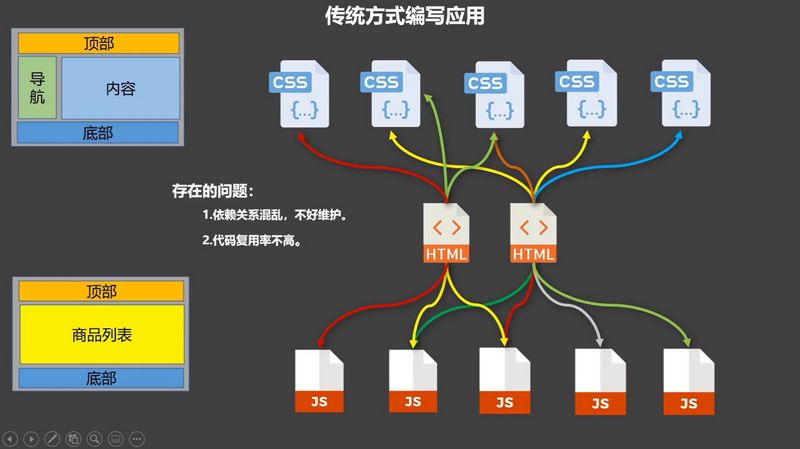
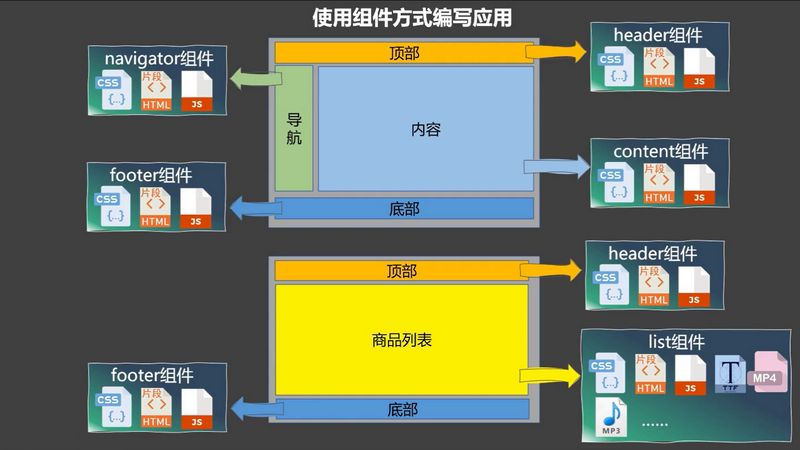
模块
- 理解:向外提供特定功能的 js 程序,一般就是一个 js 文件
- 为什么:js 文件很多很复杂
- 作用:复用、简化 js 的编写,提高 js 运行效率
组件
- 定义:用来实现局部功能的代码和资源的集合(html/css/js/image…)
- 为什么:一个界面的功能很复杂
- 作用:复用编码,简化项目编码,提高运行效率
模块化
- 当应用中的 js 都以模块来编写的,那这个应用就是一个模块化的应用
组件化
- 当应用中的功能都是多组件的方式来编写的,那这个应用就是一个组件化的应用
非单文件组件
- 非单文件组件:一个文件中包含有 n 个组件
- 单文件组件:一个文件中只包含有 1 个组件
基本使用
Vue中使用组件的三大步骤
- 定义组件
- 使用
Vue.extend(options)创建,其中options和new Vue(options)时传入的options几乎一样,但也有点区别
el不要写,因为最终所有的组件都要经过一个vm的管理,由vm中的el才决定服务哪个容器data必须写成函数,避免组件被复用时,数据存在引用关系
- 注册组件
- 局部注册:
new Vue()的时候options传入components选项
- 全局注册:
Vue.component('组件名',组件)
- 使用组件
1
2
3
4
5
6
7
8
9
10
11
12
13
14
15
16
17
18
19
20
21
22
23
24
25
26
27
28
29
30
31
32
33
34
35
36
37
38
39
40
41
42
43
44
45
46
47
48
49
50
51
52
53
54
55
56
57
58
59
60
61
62
63
64
65
66
67
68
69
70
71
72
73
74
75
76
77
78
79
80
81
82
83
84
85
86
87
88
89
90
91
92
93
94
95
96
| <title>基本使用</title>
<script type="text/javascript" src="../js/vue.js"></script>
<div id="root">
<h2>{{msg}}</h2>
<hr>
<school></school>
<hr>
<student></student>
<hr>
<hello></hello>
<hr>
</div>
<div id="root2">
<hello></hello>
</div>
<script type="text/javascript">
Vue.config.productionTip = false
const school = Vue.extend({
template: `
<div class="demo">
<h3>学校名称:{{schoolName}}</h3>
<h3>学校地址:{{address}}</h3>
<button @click="showName">点我提示学校名</button>
</div>
`,
data() {
return {
schoolName: '蒲天辉学习笔记',
address: '上海'
}
},
methods: {
showName() {
alert(this.schoolName)
}
},
})
const student = Vue.extend({
template: `
<div>
<h3>学生姓名:{{studentName}}</h3>
<h3>学生年龄:{{age}}</h3>
</div>
`,
data() {
return {
studentName: '张三',
age: 18
}
}
})
const hello = Vue.extend({
template: `
<div>
<h3>你好啊!{{name}}</h3>
</div>
`,
data() {
return {
name: '小蒲'
}
}
})
Vue.component('hello', hello)
new Vue({
el: '#root',
data: {
msg: '你好啊!'
},
components: {
school,
student
}
})
new Vue({
el: '#root2',
})
</script>
|
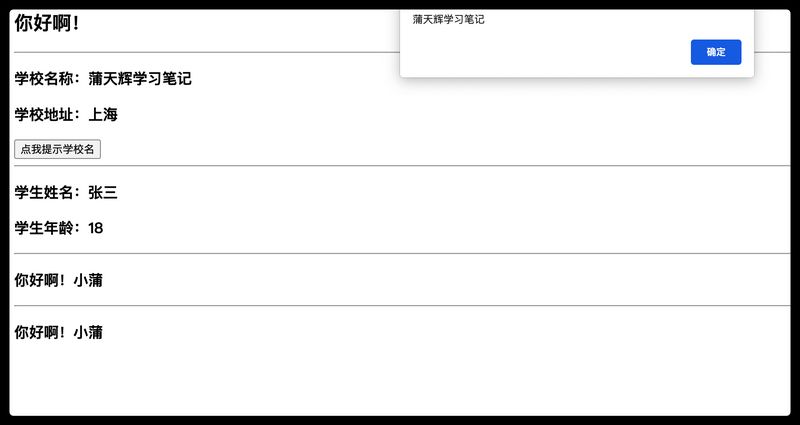
组件注意事项
关于组件名
- 一个单词组成
- 第一种写法(
首字母小写):school
- 第二种写法(
首字母大写):School
- 多个单词组成
- 第一种写法(
kebab-case 命名):my-school
- 第二种写法(
CamelCase 命名):MySchool(需要Vue脚手架支持)
- 备注
- 组件名尽可能回避
HTML中已有的元素名称,例如:h2、H2都不行
- 可以使用
name配置项指定组件在开发者工具中呈现的名字
关于组件标签
- 第一种写法:
<school></school>
- 第二种写法:
<school/>(需要Vue脚手架支持)
- 备注:不使用脚手架时,
<school/>会导致后续组件不能渲染
一个简写方式:const school = Vue.extend(options)可简写为const school = options,因为父组件components引入的时候会自动创建
1
2
3
4
5
6
7
8
9
10
11
12
13
14
15
16
17
18
19
20
21
22
23
24
25
26
27
28
29
30
31
32
33
34
35
36
37
38
| <title>几个注意点</title>
<script type="text/javascript" src="../js/vue.js"></script>
<div id="root">
<h2>{{msg}}</h2>
<school></school>
</div>
<script type="text/javascript">
Vue.config.productionTip = false
const school = Vue.extend({
name: 'XiaopuSchool',
template: `
<div>
<h3>学校名称:{{name}}</h3>
<h3>学校地址:{{address}}</h3>
</div>
`,
data() {
return {
name: 'XXX大学',
address: '上海'
}
}
})
new Vue({
el: '#root',
data: {
msg: '欢迎学习Vue!'
},
components: {
school
}
})
</script>
|

组件的嵌套
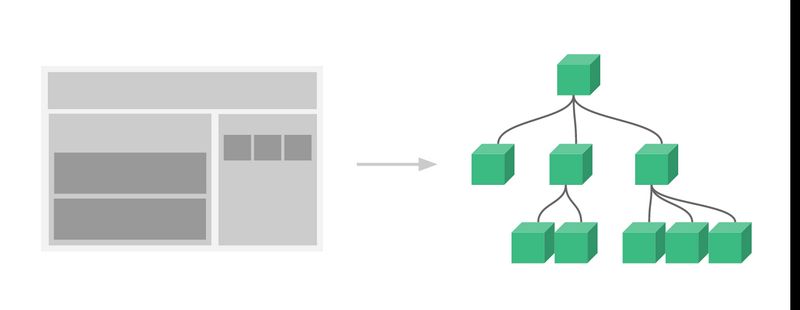
1
2
3
4
5
6
7
8
9
10
11
12
13
14
15
16
17
18
19
20
21
22
23
24
25
26
27
28
29
30
31
32
33
34
35
36
37
38
39
40
41
42
43
44
45
46
47
48
49
50
51
52
53
54
55
56
57
58
59
60
61
62
63
64
65
66
67
68
69
70
71
72
73
74
75
76
77
78
79
80
81
| <title>组件的嵌套</title>
<script type="text/javascript" src="../js/vue.js"></script>
<div id="root"></div>
<script type="text/javascript">
Vue.config.productionTip = false
//定义student组件
const student = Vue.extend({
name: 'student',
template: `
<div>
<h4>学生姓名:{{name}}</h4>
<h4>学生年龄:{{age}}</h4>
</div>
`,
data() {
return {
name: '小蒲',
age: 18
}
}
})
//定义school组件
const school = Vue.extend({
name: 'school',
template: `
<div>
<h3>学校名称:{{name}}</h3>
<h3>学校地址:{{address}}</h3>
<student></student>
</div>
`,
data() {
return {
name: '学校笔记',
address: '上海'
}
},
//注册组件(局部)
components: {
student
}
})
//定义hello组件
const hello = Vue.extend({
template: `<h3>{{msg}}</h3>`,
data() {
return {
msg: '欢迎来到小蒲学习笔记学习!'
}
}
})
//定义app组件
const app = Vue.extend({
template: `
<div>
<hello></hello>
<school></school>
</div>
`,
components: {
school,
hello
}
})
//创建vm
new Vue({
el: '#root',
template: '<app></app>',
//注册组件(局部)
components: {
app
}
})
</script>
|
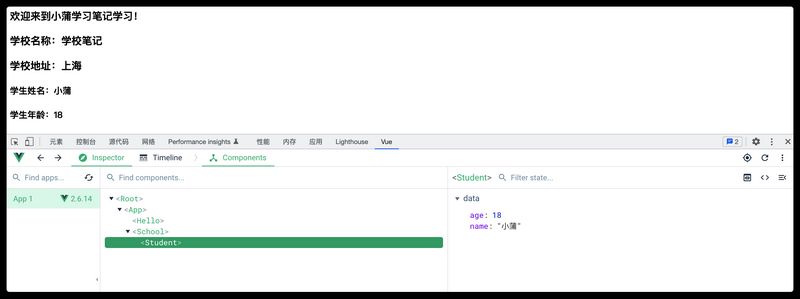
VueComponent
关于 VueComponent
school 组件本质是一个名为VueComponent的构造函数,且不是程序员定义的,而是 Vue.extend() 生成的 - 我们只需要写
<school/> 或 <school></school>,Vue 解析时会帮我们创建school组件的实例对象,即Vue帮我们执行的new VueComponent(options)
- 每次调用
Vue.extend,返回的都是一个全新的VueComponent,即不同组件是不同的对象
- 关于
this 指向
- 组件配置中
data函数、methods中的函数、watch中的函数、computed中的函数 它们的 this 均是 VueComponent实例对象
new Vue(options)配置中:data函数、methods中的函数、watch中的函数、computed中的函数 它们的 this 均是 Vue实例对象
VueComponent的实例对象,以后简称vc(组件实例对象)Vue的实例对象,以后简称vm
1
2
3
4
5
6
7
8
9
10
11
12
13
14
15
16
17
18
19
20
21
22
23
24
25
26
27
28
29
30
31
32
33
34
35
36
37
38
39
40
41
42
43
44
45
46
47
48
49
50
| <title>VueComponent</title>
<script type="text/javascript" src="../js/vue.js"></script>
<div id="root">
<school></school>
<hello></hello>
</div>
<script type="text/javascript">
Vue.config.productionTip = false
const school = Vue.extend({
name: 'school',
template: `
<div>
<h2>学校名称:{{name}}</h2>
<h2>学校地址:{{address}}</h2>
<button @click="showName">点我提示学校名</button>
</div>
`,
data() {return {name: '小蒲学习笔记',address: '上海'}},
methods: {showName() {console.log('showName', this)}},
})
const test = Vue.extend({
template: `<span>xiaopu</span>`
})
const hello = Vue.extend({
template: `
<div>
<h2>{{msg}}</h2>
<test></test>
</div>
`,
data() {return {msg: '你好啊!'}},
components: { test }
})
const vm = new Vue({
el: '#root',
components: { school, hello }
})
</script>
|
一个重要的内置关系
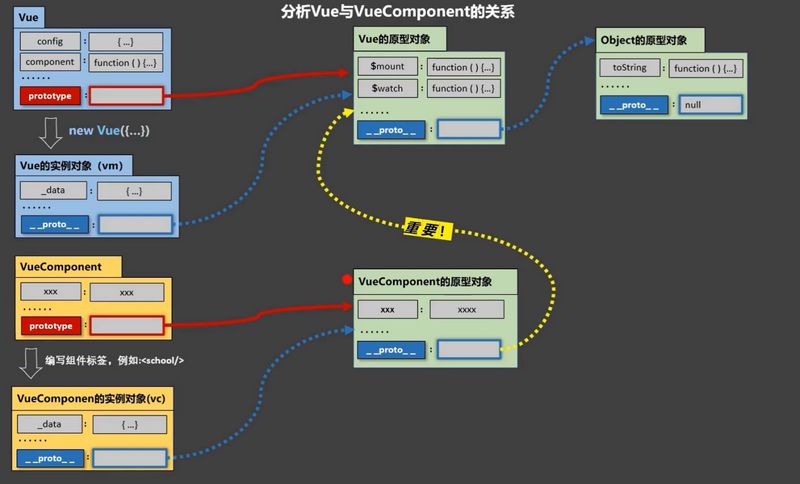
- 一个重要的内置关系:
VueComponent.prototype.__proto__ === Vue.prototype
- 为什么要有这个关系:让组件实例对象
vc可以访问到 Vue原型上的属性、方法
单文件组件
School.vue
1
2
3
4
5
6
7
8
9
10
11
12
13
14
15
16
17
18
19
20
21
22
23
24
25
26
27
28
29
30
| <template>
<div id='Demo'>
<h2>学校名称:{{name}}</h2>
<h2>学校地址:{{address}}</h2>
<button @click="showName">点我提示学校名</button>
</div>
</template>
<script>
export default {
name:'School',
data() {
return {
name:'学习笔记',
address:'上海'
}
},
methods: {
showName(){
alert(this.name)
}
},
}
</script>
<style>
#Demo{
background: orange;
}
</style>
|
Student.vue
1
2
3
4
5
6
7
8
9
10
11
12
13
14
15
16
17
18
| <template>
<div>
<h2>学生姓名:{{name}}</h2>
<h2>学生年龄:{{age}}</h2>
</div>
</template>
<script>
export default {
name:'Student',
data() {
return {
name:'xiaopu',
age:20
}
},
}
</script>
|
App.vue
1
2
3
4
5
6
7
8
9
10
11
12
13
14
15
16
17
18
19
| <template>
<div>
<School></School>
<Student></Student>
</div>
</template>
<script>
import School from './School.vue'
import Student from './Student.vue'
export default {
name:'App',
components:{
School,
Student
}
}
</script>
|
main.js
1
2
3
4
5
6
7
| import App from './App.vue'
new Vue({
template:`<App></App>`,
el:'#root',
components:{App}
})
|
index.html
1
2
3
4
5
6
7
8
9
10
11
12
13
14
| <!DOCTYPE html>
<html lang="en">
<head>
<meta charset="UTF-8">
<meta http-equiv="X-UA-Compatible" content="IE=edge">
<meta name="viewport" content="width=device-width, initial-scale=1.0">
<title>单文件组件练习</title>
</head>
<body>
<div id="root"></div>
<script src="../../js/vue.js"></script>
<script src="./main.js"></script>
</body>
</html>
|















